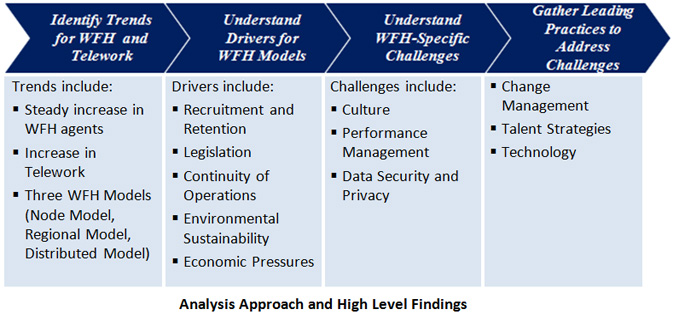In mid 2011, Purisolve was engaged by a large organization with over 15,000 call agents to examine the state of Work from Home and Telework plans run by both corporations and government entities throughout the United States. Operating under an abbreviated timeframe of 6 weeks, Purisolve created a cross functional team that had experience in the teleworking industry and contacts within it. The final deliverable expressed the articulated findings from research papers, interviews and industry analysis, with a particular emphasis on those programs that used a work from home strategy for their contact center operations.
Tasks Performed:
 The study analyzed work from home examples in four dimensions:
The study analyzed work from home examples in four dimensions:
- Workforce
- Facilities and Real Estate
- Organizational
- Technology
These dimensions gave way to a study approach shown to the right that emphasized not only understanding the trends and drivers of those trends, but the challenges that befell those that have already implemented a work from home strategy.
The research analyzed by the team concluded that many companies plan on implementing a program, though fewer have done so at the present time.
The reasons for implementing a Work from Home program were varied, but employee morale and cost savings were identified as key drivers for many organizations.
To many organizations, a Work from Home strategy seems untenable due to the risks and challenges of implementing it. From privacy and security issues to technological concerns, the number of reasons not to explore the option sometimes outweighs the number of reasons to do so. Identifying these concerns and using a solutions based approach to remedying them would seem the proper way for many organizations to form their own opinion for or against implementation.
An example of some risks and challenges involved when implementing a Work from Home model and the policies and procedures necessary to remedy it appears in the following table.
Results
The team recommended that organizations considering a Work from Home model institute a three step approach prior to full implementation.
- Perform a Cost Benefit Analysis
- Organize a Pilot
- Build a Transition Roadmap
In following this three step approach, many of the questions an organization’s executives may have regarding running a program from a cost, operational, organizational and human capital perspective can be answered, optimizing the chance of success when the model is opened to the greater organization.

